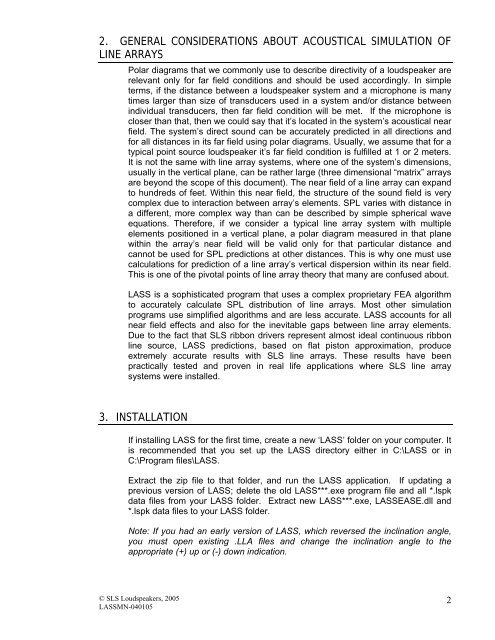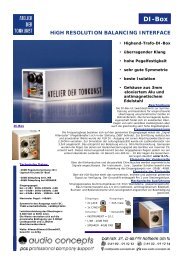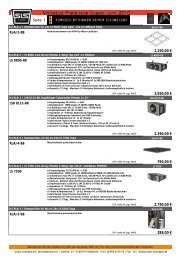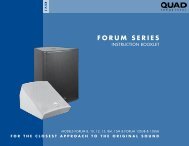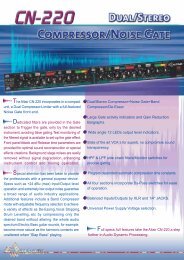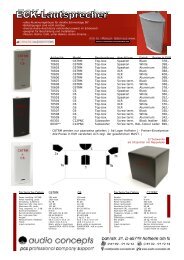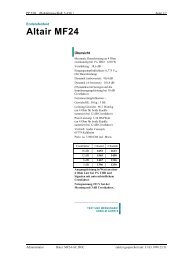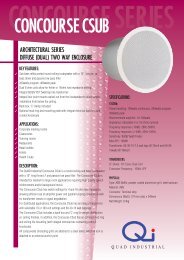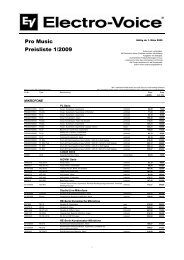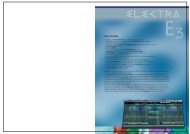LASS user manual - audio concepts
LASS user manual - audio concepts
LASS user manual - audio concepts
Create successful ePaper yourself
Turn your PDF publications into a flip-book with our unique Google optimized e-Paper software.
2. GENERAL CONSIDERATIONS ABOUT ACOUSTICAL SIMULATION OF<br />
LINE ARRAYS<br />
Polar diagrams that we commonly use to describe directivity of a loudspeaker are<br />
relevant only for far field conditions and should be used accordingly. In simple<br />
terms, if the distance between a loudspeaker system and a microphone is many<br />
times larger than size of transducers used in a system and/or distance between<br />
individual transducers, then far field condition will be met. If the microphone is<br />
closer than that, then we could say that it’s located in the system’s acoustical near<br />
field. The system’s direct sound can be accurately predicted in all directions and<br />
for all distances in its far field using polar diagrams. Usually, we assume that for a<br />
typical point source loudspeaker it’s far field condition is fulfilled at 1 or 2 meters.<br />
It is not the same with line array systems, where one of the system’s dimensions,<br />
usually in the vertical plane, can be rather large (three dimensional “matrix” arrays<br />
are beyond the scope of this document). The near field of a line array can expand<br />
to hundreds of feet. Within this near field, the structure of the sound field is very<br />
complex due to interaction between array’s elements. SPL varies with distance in<br />
a different, more complex way than can be described by simple spherical wave<br />
equations. Therefore, if we consider a typical line array system with multiple<br />
elements positioned in a vertical plane, a polar diagram measured in that plane<br />
within the array’s near field will be valid only for that particular distance and<br />
cannot be used for SPL predictions at other distances. This is why one must use<br />
calculations for prediction of a line array’s vertical dispersion within its near field.<br />
This is one of the pivotal points of line array theory that many are confused about.<br />
<strong>LASS</strong> is a sophisticated program that uses a complex proprietary FEA algorithm<br />
to accurately calculate SPL distribution of line arrays. Most other simulation<br />
programs use simplified algorithms and are less accurate. <strong>LASS</strong> accounts for all<br />
near field effects and also for the inevitable gaps between line array elements.<br />
Due to the fact that SLS ribbon drivers represent almost ideal continuous ribbon<br />
line source, <strong>LASS</strong> predictions, based on flat piston approximation, produce<br />
extremely accurate results with SLS line arrays. These results have been<br />
practically tested and proven in real life applications where SLS line array<br />
systems were installed.<br />
3. INSTALLATION<br />
If installing <strong>LASS</strong> for the first time, create a new ‘<strong>LASS</strong>’ folder on your computer. It<br />
is recommended that you set up the <strong>LASS</strong> directory either in C:\<strong>LASS</strong> or in<br />
C:\Program files\<strong>LASS</strong>.<br />
Extract the zip file to that folder, and run the <strong>LASS</strong> application. If updating a<br />
previous version of <strong>LASS</strong>; delete the old <strong>LASS</strong>***.exe program file and all *.lspk<br />
data files from your <strong>LASS</strong> folder. Extract new <strong>LASS</strong>***.exe, <strong>LASS</strong>EASE.dll and<br />
*.lspk data files to your <strong>LASS</strong> folder.<br />
Note: If you had an early version of <strong>LASS</strong>, which reversed the inclination angle,<br />
you must open existing .LLA files and change the inclination angle to the<br />
appropriate (+) up or (-) down indication.<br />
© SLS Loudspeakers, 2005<br />
<strong>LASS</strong>MN-040105<br />
2


